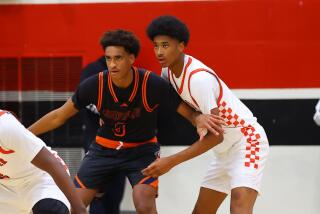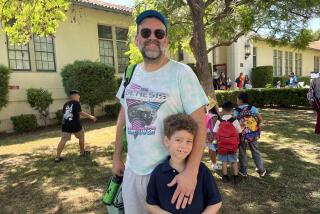The 4th R-Riding
- Share via
Waking before dawn to the blare of her alarm and the crow of a neighbor’s rooster, Jacqueline Hernandez begins her school day and prepares for the collision of her two worlds.
Jacqueline lives in an inner-city, working-class neighborhood in South-Central Los Angeles a few miles east of USC, but her neighborhood high school doesn’t have room for her.
So she travels 38 miles every weekday morning to Chatsworth High School, nestled in a suburban world of green, manicured lawns and middle-class homes.
She’s one of 11,000 students, mostly kids from South-Central, who are bused by the Los Angeles Unified School District to schools out of their neighborhoods because their local campuses are overcrowded.
She and the 40 other neighborhood kids on bus No. 4068 have an hour’s ride each way to Chatsworth High, perhaps the longest daily commute.
For the 16-year-old sophomore, her well-timed morning ritual begins at 5 a.m. One minute she spritzes on hair spray in front of the bathroom mirror, another she’s sliding rings and bracelets on her fingers and wrists, and the next, she’s sitting on the living room couch, carefully dabbing gold glitter on her straight, black ponytail.
By 5:55 a.m., Jacqueline has stuffed books and a makeup kit into her backpack and is leaving the tidy, one-bedroom apartment she shares with her mother and brother to catch the bus at 6:20 a.m.
There are 89 overcrowded elementary, middle and high schools in the district’s Capacity Adjustment Program (CAP) that must find room at other campuses for their excess students. Once a school’s enrollment reaches capacity, students who want to enroll are put in the program.
In Jacqueline’s case, the students “capped” out of Jefferson High School, her home campus, have the choice of being bused to one of three alternatives: Chatsworth High, Lincoln High or Los Angeles Trade Tech.
A Matter of Space
Students who prefer their new school may continue there even if a space opens up at their neighborhood school, said Bruce Takeguma, LAUSD assistant director of school management services who oversees the placement of CAP students.
After students are placed in CAP, they are given priority for enrollment at their home schools for the next school year. The number of students in CAP has decreased from about 25,000 in 1979-80 to about 11,000 now after the institution of year-round schools, students on multiple tracks and additional classrooms, said Theodore Alexander, director of the district’s office of school integration.
In May, LAUSD administrators moved to relieve the situation by approving a $1.8-billion plan to build 51 new year-round schools in the next eight years.
But for kids like Jacqueline, the new schools will arrive too late.
In spite of her long commute, she shows remarkable resiliency, and says she enjoys attending the sprawling open-air Chatsworth campus and being part of the ethnically diverse student body.
“In the beginning [of this school year], it was tough,” she said. “I wasn’t used to waking up so early.”
As a freshman, Jacqueline traveled a slightly shorter distance to Lincoln High School in Lincoln Heights. This academic year, she had first priority for getting into Jefferson, but she missed the enrollment deadline and was directed to Chatsworth.
Walking the six blocks to Jefferson to catch their bus, Jacqueline and her brother, Michael, a Chatsworth High freshman, trudge along garbage-strewn sidewalks, shuffle past buildings spray-painted with the territorial boundary markers of local gangs and ignore an occasional prostitute--common images in their neighborhood.
Jacqueline, a polite, soft-spoken teenager who hopes to attend Cal State Los Angeles and become a social worker, said she blocks out many of her neighborhood’s distractions by literally and figuratively transporting herself out of South-Central.
“I don’t mind the ride,” she said. “I actually like traveling to Chatsworth.”
But what price happiness?
Jacqueline and Michael sacrifice attending football games and participating in after-school activities in favor of getting home by 4 p.m. She said that gives them enough time for homework and dinner before getting to bed by 9:30 p.m.
And besides, Jacqueline said, their mother, Estela, won’t allow them to join extracurricular clubs because they would have to take a 5 p.m. bus that wouldn’t get them home until nearly 7 p.m.
“My mom is very overprotective of me, especially me being the youngest female,” Jacqueline said. Jacqueline has two sisters, Violet Martinez, 20, a UCLA sophomore, and Sylvia Lopez, 29, and another brother, Sal Martinez, 23.
“She doesn’t want me [and Michael] walking home when it gets dark,” she said.
For Estela, who sews swimsuits at a South-Central garment factory, the long commute has its pros and cons.
“I feel bad that Jacqueline and Michael just go to school and come straight home and that’s it,” she said. “It’s not fair when other kids get to have fun after school.”
A Mother’s Concerns
However, she said she believes that Chatsworth is a better alternative than attending school in their neighborhood, which has a higher gang population. Still, she wishes her kids didn’t have to travel so far and that she had a car.
“I’m worried that in an emergency I won’t be able to get over to Chatsworth if anything happens,” Estela, 47, said in Spanish as Jacqueline translated.
For Jacqueline and her friends on bus No. 4068, the compromises they make--the wasted hours on the bus, the difficulty in participating in after-school activities and the inability to interact with Chatsworth classmates after school--distinguish their uncommon high school experience.
Maria Gonzalez, 16, who often sits next to Jacqueline on the bus, said she would have liked to join the school’s track team.
“I wanted to try jumping hurdles, but my mom is [also] afraid that something might happen to me on the way home at night,” she said. “I would like to do more school activities, but most of my friends can’t either.”
But Jacqueline maintains that the distant school allows her to experience a new environment with teachers who seem to care and challenge students.
However, those perceived benefits do not necessarily translate into better grades. According to the district’s most recent comprehensive study, 1989-90 California Test of Basic Skills (CTBS) scores in reading and mathematics of 10th grade CAP students were markedly lower than those of resident students in the same schools.
CAP students at schools such as Chatsworth scored in the 21st and 25th mean percentile in reading and math, respectively. In contrast, resident students scored in the 47th and 66th mean percentile in the same respective categories.
In fact, Jacqueline is in danger of failing her biology class. More often than not, the commute is an added hindrance, preventing students from concentrating on academic performance, said Ethlene Pollak, Jacqueline’s biology teacher.
“The busing is not going to change things. The problem will still exist because it’s about poverty,” Pollak added.
Ebrahim Maddahian, who completed the CTBS study as a member of the district’s evaluation planning team, said the primary goal of CAP is to relieve overcrowding in schools, not necessarily to ensure an improved academic performance. In general, CAP students’ achievement is comparable to that of students at their neighborhood schools, he said.
Although the ride home for the kids on bus No. 4068 takes at least an hour, few kids use the time to study. Most kids sleep, heads leaning against bus windows or bodies stretched across cushioned seats. Even Jacqueline can’t fight the urge to nap briefly as the bus chugs south along the Golden State Freeway.
This Friday, Jacqueline completes her final two-hour, 76-mile round-trip journey as school lets out for summer recess.
Which begs the question: Where will Jacqueline be next September?
“I want to come back to Chatsworth,” she said. “I hate starting all over again. I don’t want to do that.”
(BEGIN TEXT OF INFOBOX / INFOGRAPHIC)
The Long Commute
Every school day, Jacqueline Hernandez begins her journey at 6:20000 a.m. in South--Los Angeles. A school bus takes her 38 miles through downtown and into the San Fernando Valley, where it arrives at 7:20 a.m. at Chatsworth High School.
More to Read
Sign up for Essential California
The most important California stories and recommendations in your inbox every morning.
You may occasionally receive promotional content from the Los Angeles Times.










